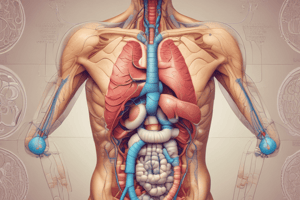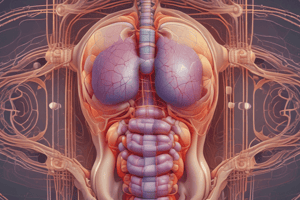Podcast
Questions and Answers
What is the main function of the gastrointestinal tract?
What is the main function of the gastrointestinal tract?
breaking down and absorbing nutrients from food
What type of digestion occurs in the mouth?
What type of digestion occurs in the mouth?
mechanical and chemical digestion
What is the role of gastric juice in the stomach?
What is the role of gastric juice in the stomach?
to break down proteins and fats
What is the primary function of the small intestine?
What is the primary function of the small intestine?
What is the role of the large intestine in the GI tract?
What is the role of the large intestine in the GI tract?
What is the mechanism of nutrient absorption in the small intestine?
What is the mechanism of nutrient absorption in the small intestine?
Flashcards are hidden until you start studying
Study Notes
Overview of Gastrointestinal Physiology
- The gastrointestinal (GI) tract, also known as the digestive system, is a complex system responsible for breaking down and absorbing nutrients from food.
- The GI tract consists of the mouth, esophagus, stomach, small intestine, and large intestine.
Mouth and Esophagus
- The mouth is responsible for mechanical and chemical digestion of food through chewing and saliva production.
- Saliva contains enzymes like amylase and lipase that break down carbohydrates and fats.
- The esophagus is a muscular tube that propels food into the stomach through peristalsis.
Stomach
- The stomach is a muscular sac that secretes digestive enzymes and acids to break down proteins and fats.
- Gastric juice contains pepsin, which breaks down proteins into peptides and amino acids.
- Hydrochloric acid (HCl) and mucus protect the stomach lining from acid damage.
Small Intestine
- The small intestine is responsible for most of the nutrient absorption in the GI tract.
- Microvilli on the surface of enterocytes increase the surface area for absorption.
- Nutrients are absorbed into the bloodstream through facilitated diffusion and active transport.
Large Intestine (Colon)
- The large intestine is responsible for water and electrolyte absorption, as well as the storage and elimination of waste.
- The colon is home to a diverse microbiome that helps with fermentation and vitamin production.
- The rectum stores feces until they are eliminated through the anus.
Hormonal Regulation
- Hormones play a crucial role in regulating digestion and absorption in the GI tract.
- Gastrin stimulates the release of gastric acid and pepsin in the stomach.
- Secretin stimulates the release of bicarbonate-rich pancreatic juice to neutralize stomach acid.
- Cholecystokinin (CCK) stimulates the release of bile and pancreatic enzymes.
Gut-Brain Axis
- The GI tract is connected to the central nervous system through the vagus nerve and other pathways.
- The gut microbiome produces neurotransmitters and hormones that influence mood and cognition.
- The brain can influence gut function and digestion through the gut-brain axis.
Studying That Suits You
Use AI to generate personalized quizzes and flashcards to suit your learning preferences.




